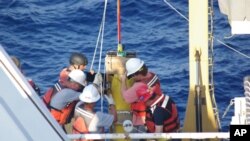There are no reliable estimates of exactly how much oil has leaked into the Gulf of Mexico since the
April 20 explosion aboard the Deepwater Horizon oil platform.
The fatal disaster sank the rig and left its 1600-meter-deep well gushing plumes of crude oil and natural gas.
So far, the best estimates of how much oil is venting into the Gulf range between 5,000 to 100,000 barrels per day.
Unknown variable
According to BP, the British oil company leasing the ill-fated rig, 5,000 barrels of oil per day are gushing from the broken well.
BP made its calculation - based on observations from ships, airplanes and satellites - of the thickness and extent of the oil slick they saw spreading on the surface and which has now reached Gulf coast shorelines.
University of California earth science professor David Valentine says surface observations, used for tracking oil tanker spills, don't readily apply to the deep ocean.
"Especially when you have oil traveling such great distances from the sea floor to the sea surfaces and when you have dispersants and other things that are acting on the oil that might may impact the shape and thickness of the sheen at the sea surface."
Different priorities
BP officials say their priority right now is to stop the leak.
BP spokesman Tom Mueller told the New York Times the company doesn't plan to make any extra efforts to calculate the flow.
"It's not relevant to the response effort," Mueller says, adding that it might even detract from the effort.
Earth scientist Valentine believes the opposite is true: "If we don't know the total amount we are never really going to know where it all went."
In the May 27 edition of the British science journal Nature, Valentine proposes a quick and accurate method for calculating the rate of the spill.
Calculating extent of the spill
He says a more precise estimate of the volume of the spill could be achieved - using existing technology - by measuring methane, the gas which comprises 40 percent of the mass of the leaking petroleum.
Unlike oil which forms globules in water, Valentine says methane dissolves in and moves with the ocean currents as it rises from the ruptured pipe making it easy to measure.
"If we are able to then go in and determine the total amount of methane, right there we have a very large component of the total oil spilled and it's a fairly simple conversion to figure out what the actual amount of spillage was."
Valentine, who has studied natural methane seeps in the ocean, says scientists can measure the methane in the area around the leak by following the methane plumes.
"The methane that you see is going to be very, very high in concentration compared to anything in the background," he says. "So what we really get is a minimum value. We can say the leakage was at least this much."
Valentine says the U.S. academic research fleet has vessels that can do the job at a cost of a few million dollars or less, but that timing is crucial in reducing the impact of the Gulf oil spill. In his Nature commentary Valentine writes that, "capitalizing on this idea requires immediate action," and he adds "the likely rewards far exceed the costs."









